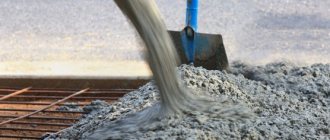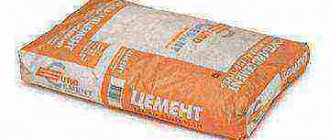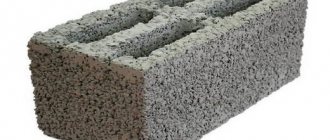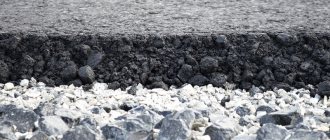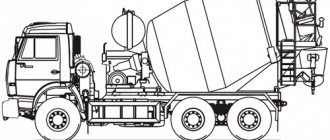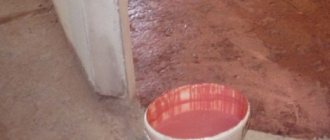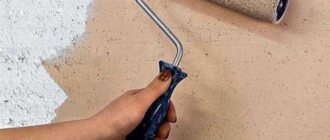Crushed stone and gravel are used in almost all construction work. These naturally occurring minerals are formed from rocks. Outwardly they are very similar, but upon closer examination, it becomes obvious that bulk materials have significant differences. To understand what granite crushed stone is, let’s consider all the varieties of this raw material.
Features of gravel
If we talk about what gravel is, then first of all you should pay attention to the shape of this mineral. Multi-colored, round-shaped stones are obtained through the natural destruction of rocks.
Depending on the fraction of this raw material, three types of gravel are distinguished:
- from 1 to 1.25 mm – fine gravel;
- up to 5 mm – medium;
- 10 mm – coarse gravel.
Raw materials cost about 1,700 rubles per cubic meter.
Since this material is extracted from different regions, there are quite a few varieties of this raw material.
Types of crushed stone[ | ]
Granite crushed stone[ | ]
Granite crushed stone
is crushed stone made from solid rock with a granular structure, which is the most common on Earth.
Granite rock is magma frozen at great depths. Consisting of well-formed crystals of feldspar, quartz, mica, etc. And has a color of red, pink or gray, depending on the predominance of spar and mica in it. Blocks are usually obtained by exploding a monolithic rock, then they are crushed in a machine, and the resulting crushed stone is sifted into fractions. This is the last stage of crushed stone production. Granite crushed stone fractions
- 0-5 mm (granite screening-ShchPS) is the smallest fraction of granite crushed stone, in the strict sense it does not belong to crushed stone, but is a by-product during its production. It is used as a decorative material for finishing, as well as for filling paths and roads, children's and sports grounds; for the manufacture of concrete products, in particular with the surface of “washed concrete”;
- 0—10 mm (ShchPS)
- 5-10 mm is the finest fraction commercially available. Used in the production of concrete and structures made from it to optimize the fractional composition of coarse aggregate, for example in the production of floor slabs using a formless method;
- 5-20 mm (a mixture of fractions 5-10 and 10-20) - is in greatest demand. Used in the production of concrete and structures made from it, in foundation work, when pouring bridge structures, bridge decks, road and airfield surfaces;
- 20-40 mm - average fraction. It is used in the production of concrete, reinforced concrete structures, in the construction of roads and railways, tram lines, in laying foundations and erecting industrial buildings;
- 25-60 mm - fraction used in the construction of foundations for railway tracks;
- 20-70 mm, 40-70 mm - coarse fraction, used in the production of concrete, massive structures made from it and for work with large volumes of concrete. It is also used in road construction within populated areas, during the construction of industrial buildings and structures;
- 70-120 mm, 120-150 mm, 150-300 mm (RUB) - rubble stone, used for backfilling, in gabions, for decorative purposes, usually for finishing fences, reservoirs, pools.
These are the standard, most common ways to use these fractions of granite crushed stone, however, for each of them there are many application options.
According to technical characteristics, granite crushed stone is durable (grade 800-1200) and high-strength (grade 1400-1600), frost-resistant (grade 300-400), with low flakiness (5-23%) and class 1 specific effective activity Aef (less than 370 Bq /kg).
The good properties of granite make it a popular building material. This is the best aggregate for high-quality concrete. Granite is also used as a decorative stone. It can be gray, red or pink and has many shades, after sanding and polishing it has a beautiful mirror surface. Granite mainly consists of feldspar, quartz, and mica crystals, the content of which affects the color and shades of the stone.
Crushed gravel[ | ]
Crushed gravel
- crushed stone obtained by crushing gravel into various fractions - 3-10 mm, 5-20 mm, 5-40 mm, 20-40 mm. Crushed gravel is used for foundation work, for concrete, in the production of reinforced concrete products, and in road construction. Crushed gravel is gravel that has been crushed by crushing or any other mechanical method and has 2 or more chipped sides of the stone.
Crushed limestone[ | ]
A product of crushing limestone, consisting mainly of calcite (calcium carbonate - CaCO3).
Limestone crushed stone (sometimes also called limestone or dolomite crushed stone) is one of the main types of crushed stone, which, in addition to gravel and granite crushed stone, is used in road construction, as well as in the manufacture of reinforced concrete products. It is also allowed to be used in drainage installations, provided that it has a sufficiently dense structure.
Recycled crushed stone[ | ]
Crushed stone obtained by crushing construction waste - concrete, brick, asphalt. To obtain it, the same equipment is used as in the production of other types of crushed stone, the process consists of the following main stages: first, construction waste is placed into the feeder hopper using a loader, then the crusher breaks large pieces into crushed stone, after which metal inclusions are sampled ( for scrap metal) and further fractionation of crushed stone on a screen (the unsorted fraction is also in demand).
The main advantage of recycled crushed stone is its low cost; on average, it is two times cheaper than granite. Energy consumption for its production compared to other types of crushed stone can be up to 8 times less. The cost of concrete using recycled crushed stone as a coarse aggregate is reduced by a quarter.
Recycled crushed stone has a wide range of applications:
- as a coarse aggregate for concrete with a strength of 5-20 MPa;
- in the road sector (filling roads, ramps, using roads that do not have federal status as the bottom layer);
- in landscaping works (pouring under asphalt areas, sidewalks);
- for strengthening weak soils (trenches of utility networks, bottoms of pits).
Slag crushed stone[ | ]
Slag crushed stone is obtained by crushing waste metallurgical slag or special processing of fiery liquid slag melts (cast slag crushed stone). Currently, various types of concrete have been developed and used in construction using both binders and fillers based on metallurgical slag. The cost of products made from slag concrete is 20-30% less than traditional ones. Depending on the grain size, crushed stone is divided into fractions: 5-10, 10-20, 20-40, 40-70, 70-120 mm. The grain composition of slag crushed stone, like other types of filler, is selected to ensure minimal voids. The minimum bulk density of crushed stone of each fraction is 1000 kg/m3. The content of lamellar (flaky) and needle-shaped grains should be for crushed stone: cuboid - no more than 15%; improved - 25%; regular - 35%. The length of such grains is three or more times greater than their thickness or width.
Along with dense waste slag, porous slag is used for the production of crushed stone, formed from melts with high gas saturation, swelling with bubbles of released gases. Slag crushed stone is used not only as a filler for cement concrete, but also in road construction to strengthen foundations and construct asphalt concrete pavements.
Crushed stone grade by strength[ | ]
The strength of slag crushed stone is characterized by its grade. For crushed stone from blast furnace slag used as a filler for heavy concrete, five strength grades have been established:
Crushed stone grade M1200 can be used in the production of concrete grade M400 and above, M1000 - grade M300, M800 - grade M200 and M600 - below grade M200. Low-grade crushed stone is also used in the production of concrete of higher strength, but after appropriate testing and a feasibility study.
Types of gravel
The following types of colored gravel are distinguished:
- River. This type of raw material is extracted from river beds, after which the material is sifted to separate the sand from it. River gravel is frost-resistant and durable.
- Mountain. The main difference between this raw material is the rough surface of the particles. Mountain gravel contains many impurities (clay and dust), so it is more often used in road construction.
- Decorative. This material is widely used in landscape design (for making gravel paths in the country, for creating a drainage system for plants and decorating ponds). Decorative material comes in a variety of colors and fractions.
- White gravel. This type of gravel is used both for country paths and for decorating flower beds. In addition, the decorative material allows you to: slow down the growth of weeds, reduce temperature changes in the soil and reduce moisture evaporation. This stone looks especially beautiful in proper lighting in the evening.
- Rounded. This decorative material is used for flooring and roofing. It also makes beautiful and practical gravel paths.
However, today not only colored gravel is used, but also specialized:
Building
Inorganic bulk building material has the following properties:
- Fraction size from 3 to 150 mm.
- Bulk density from 1.4 to 3 g/cm3.
- Specific gravity is about 1400 kg per cubic meter.
- Compressive strength 1.5 t/cm2.
- Frost resistance from F15 to F
This raw material is also considered the most durable.
Shungizite
This environmentally friendly raw material is considered a universal thermal insulation material with a long service life. If you use shungizite gravel as a filler for concrete, you will get a lightweight and frost-resistant building material. It also makes high-quality gravel paths that will not accumulate moisture.
Silicic
Raw materials of this type are most often used as a bottom filter for country wells. Due to its properties, silicon stone is able to retain organic matter and heavy metals. Water that passes through the filter is purer and has better taste.
Glacial
This raw material has good adhesive properties, which is why it is often used in the construction of monolithic concrete structures. Concrete made with such gravel is characterized by increased strength and durability.
Washed
Unlike other types of gravel, only washed raw materials contain no impurities that can worsen the characteristics of the concrete solution. Thanks to the use of washed gravel (it is better to buy land gravel rather than river gravel), the concrete mass will not crack and empty cavities will not form in it.
There is also a type of gravel called gravel mixture.
Gravel mixtures
Today, enriched sand and gravel mixtures, or, as they are also called, OPGS, are often found on sale. Such compositions are mixed with cement and water to obtain a higher quality building material. During the preparation process, it is important to adhere to certain proportions and quality of components, otherwise the use of OPGS will not be justified.
Healthy! Natural mixtures contain no more than 20% gravel; after enrichment, its content increases to 75%.
The sand-gravel mixture contains the following components:
- crushed gravel or gravel of different fractions – 70%;
- sand without impurities – 30%.
Clay content is also allowed in the composition, but not more than 1%.
Along with enriched sand-gravel mixtures, gravel screenings are also available on sale. Essentially, this raw material is waste that is obtained during the crushing of rocks.
The cost of such screenings is much lower, so thanks to this material it is possible to significantly reduce the cost of construction work. Gravel waste is used both in the manufacture of reinforced concrete structures and in site design (gravel paths as in the photo, sports fields, flower beds and much more).
To determine the difference between gravel and crushed stone, consider the features of another building material.
What is the difference between crushed stone
Crushed stone and gravel are small rocks. The diameters of their particles can be as small as 5 mm and reach up to 200 mm.
You can read about what crushed granite stone GOST 8267 93 is from this article.
The photo shows the difference between crushed stone and gravel:
Differences in production processes
The gravel has a round shape with fuzzy edges. Found in nature in the form of rock particles. It is formed as a result of temporary rock splitting. It is industrially collected from the stone surface using special equipment. Then the gravel undergoes calibration and screening, and, if necessary, washing. As a result, the material obtained after all operations is gravel.
The GOST crushed stone fraction and other characteristics can be read in the article.
The video explains the difference between crushed stone and gravel:
Since it is obtained as a result of the natural and prolonged destruction of rocks, it has not only a smooth surface, but also many foreign inclusions, such as clay, sand, particles of organic substances and others. This leads to the fact that the material must be sorted into fractions, sifted, and in some cases washed, which makes the production process more labor-intensive. But as a result of this, the building material gets rid of impurities.
The difference between gravel and crushed stone can be found in the article.
It consists of various rocks and minerals, so when assessing its strength, the weakest grains from several batches are selected. There are several types of gravel, depending on where the material is mined. There are: sea, river and mountain. It is the mountain subspecies that has found application in construction.
Crushed stone is also the result of crushing rocks, but to obtain it, they do not wait for their natural destruction, but use special equipment. It can be a by-product during mining and processing operations. Several types of technology are used for its production. Depending on the size of the material required, the type of crushing machines is selected. If it is mined in a quarry, then stationary equipment is used, and if in hard-to-reach places, then mobile models are used.
The weight of crushed stone of fraction 20-40 per 1m3 and other characteristics of the building material can be found in the article.
When purposefully extracting crushed stone, a rock explosion is first carried out; for this, a hole is cut in the mountain rocks into which explosives are placed. After the explosion, experts check the size of the rock fragments, and if the stone is large, it is undermined again.
After this, using special machines, the resulting fragments are delivered to crushing and screening machines (mills and screens), and they crush the rock to the required size.
In the case of mining and processing operations, crushed stone is obtained as a by-product. The resulting rocks are sifted, and after that the “empty” fraction, which does not contain the necessary substances, is selected. Most often, blasting is used to produce crushed stone, so its extraction is more labor-intensive than gravel.
For those who want to know how much sand, crushed stone, cement is in a cube of concrete, you can find out from the article.
What does gravel look like?
Externally, you cannot confuse these materials and how they look. Let's start with the fact that crushed stone is presented in one gray color, while gravel has different colors, so it is more often used for decoration. Unlike crushed stone, it has clear shapes formed by nature.
Depending on the location of extraction, gravel is divided into the following types:
- mountain;
- granite;
- nautical;
- river.
The article describes the fraction of crushed stone 40 70 and other characteristics of the building material.
Streamlined shapes due to contact with water have a river and marine appearance, so it is more often used for decorative purposes, since its rounded edges do not adhere well to other substances. For concrete work, glacial (granite) and mountain crushed stone is used. The latter varieties can be confused with each other.
Gravel is divided into three subgroups depending on the parameters of its particles:
- small stones, the size of which reaches from 1 mm to 1.25;
- medium, reaching 5 mm;
- large particles over 10 mm.
Compared to gravel, crushed stone has a more angular and rough shape, thanks to which it is more in demand in construction. It has excellent adhesion to other materials and is a good filler for construction voids.
For those who want to know what the volumetric weight of crushed stone is, it is worth reading this article.
Dimensions are related to the scope of its application:
- minimum fractions of up to 5 mm are used for roads; they are used to sprinkle paths against ice;
- over 5 and up to 10 mm are used in concrete work and the production of building slabs;
- stones up to 20 mm are used in the construction of bridges and serve as the basis for asphalt roads, and are also used when pouring foundations for buildings;
- fractions over 20 mm, but less than 40 are used for the construction of complex structures;
- up to 70 mm – participate in the construction of multi-storey buildings;
- over 70 and up to 120 mm are used for decorative purposes.
You can find out the differences between crushed stone and gravel here in the article.
Crushed stone has high strength and resistance to low temperatures. According to the degree of frost resistance, it has several groups. As you can see, crushed stone is more varied in size than gravel.
Interaction with other materials
Considering the fact that gravel has more rounded shapes, it is significantly inferior in adhesion characteristics to other building materials compared to crushed stone. The presence of corners and a rough plane in the latter contributes to better bonding with concrete and optimal compaction. It is capable of filling any construction voids. For example, when constructing a rubble foundation, they, together with cement, fill the internal part, made of large stones that do not fit tightly together.
Areas of application
The characteristics of crushed stone have found application in construction work during the construction of reinforced concrete structures and concrete objects. Its finest fraction is used for sprinkling paths during icy conditions, as well as for leveling sports fields.
For those who are interested in knowing what heavy concrete consists of, you can read this article.
Due to its decorative form, gravel is used more often in landscape design:
- when decorating garden paths and flower beds;
- for decorating building facades;
- they make models of ponds;
- it is filled in on the site of roads and various recreation areas.
Gravel is also used in construction as a “cushion” in the foundation. It is also useful to read about the use of pebbles in landscape design.
Features of crushed stone
Crushed stone is an inorganic raw material that is mined by crushing granite, boulders, limestone and other rocks. The main difference between crushed stone and pebbles is its rough surface and the presence of very sharp corners. In addition, crushed stone is large in size, so it is rarely used for country side walkways. Thanks to larger fractions, this material has good “adhesion”, so it is successfully used as a filler for building mixtures.
Healthy! If we talk about the differences between crushed gravel and ordinary gravel, then you should pay attention to the method of extracting raw materials. Crushed gravel is mined by crushing rocks, so it has sharper corners. Ordinary crushed stone forms independently, under the influence of water.
If we talk about the sizes of stones, then according to GOST there are the following categories:
- Up to 5 mm (screening), suitable for paths, platforms and as protection against ice.
- From 5 to 10 mm, used as filler for concrete mixtures.
- From 10 to 20 mm, used to create a foundation for construction.
- From 20 to 40 mm – for complex structures of heavy weight.
- From 40 to 70 mm – for the construction of road surfaces and multi-storey buildings.
- From 70 to 120 mm - as decorative elements.
It is also worth paying attention to how much a cube of crushed stone weighs.
| Type of crushed stone and scope of use | Specific gravity, 1m3/kg | Bucket weight (12 l), kg |
| Slag (rarely used) | 1500 | 18 |
| Granite (used for making hard concrete, for pouring foundations, for road construction) | 1470 | 17,5 |
| Limestone (for low-rise construction, in the production of reinforced concrete concrete, wells and much more) | 1300 | 15,5 |
| Sandstone (road construction) | 1300 | 15,5 |
| Marble (landscape design: paths in the country, de-icing coatings, drainage systems) | 1500 | 18 |
| Waste waste (road coverings) | 1150 | 14 |
| Tuff (rarely used) | 800 | 9,5 |
Based on this, we can conclude that the bulk density of some types of crushed stone is significantly lower than that of gravel.
The cost of crushed stone is about:
- 1,500 rubles per 1m3 of limestone raw materials;
- 2,100 rubles – granite;
- 1,150 rubles – slag.
Properties of crushed stone
Crushed stone is a small stone, up to 0.1 cm, obtained by grinding rocks, including gravel and boulders of various sizes. Due to its relatively pure composition and high angularity, it is indispensable in the production of concrete mixtures, as well as as a road surface or one of its layers. The increased demand for crushed stone has forced us to study the material more deeply and develop it according to standards, categories and characteristics. Some of the most important properties of crushed stone include size (fractionality) and flakiness (flatness of shape). Differences in fractions divide the material according to purpose and area of use, the most popular are fractions of 0.2-0.6 cm. Flakiness is determined by the length and degree of flatness of the crushed stone.
Thin plates with high needleness have high fragility and strength, which makes the resulting mixtures of low strength. High compaction characteristics make the material unsuitable for creating structures with high loads. High-quality crushed stone should have a cube shape, which has sufficient volume and sharp corners to ensure high adhesion characteristics.
Crushed stone is mined using a quarry method. In its primary form, crushed stone is similar to gravel, but then it undergoes special processing at a mining processing plant where it is crushed, cleaned and fractionated. In construction, crushed stone is most in demand, as it has a special preparation that increases its performance.
The cost depends on the species from which the building material is made. Crushed granite is stronger and more expensive, while gravel is less dense and cheaper. The formation of value is influenced by the effort spent on production. So, when processing crushed stone, it becomes possible to utilize construction waste to create secondary material.
Classification of crushed stone
Crushed stone is classified according to several criteria. First of all, you should pay attention to its brand:
- M 1200 – 1400 – high strength material;
- M 800 – 1200 – durable crushed stone;
- M 600 – 800 – medium strength raw materials;
- M 300 – 600 – low-strength material;
- M 200 – crushed stone of the lowest strength.
Crushed stone is also distinguished by the number of irregularly shaped grains:
- Group 1 – the content of grains whose length is 3-4 times greater than their thickness is less than 10% of the total mass of raw materials;
- Group 2 – from 10% to 15%;
- Group 3 – from 15% to 25%;
- Group 4 – from 25% to 35%;
- Group 5 – from 35% to 50%.
To summarize, let’s consider in which areas it is better to use gravel, and in which crushed stone.
Strength of crushed stone
The strength of crushed stone is characterized by the tensile strength of the original rock during compression, the crushability of crushed stone during compression (crushing) in the cylinder, and wear in the shelf drum. These indicators simulate the resistance of stone material under the influence of vehicles passing along the road and mechanical impacts during the construction of road structures (laying and compaction with rollers).
Depending on the grade, crushed stone is divided into groups:
- high-strength - M1200-1400,
- durable - M800-1200,
- medium strength - M600-800,
- weak strength - M400-600,
- very weak strength - M200.
In crushed stone, the content of grains of weak rocks is normalized with the ultimate strength of the original rock under compression in a water-saturated state of up to 20 MPa.
According to GOST 8267-93, crushed stone of the M1400, M1200, M1000 brands should not contain grains of weak rocks in an amount of more than 5%, crushed stone of the M800, M600, M400 brands - more than 10%, crushed stone of the M300 and M200 brands - more than 15% by weight.
What to choose
If we talk about what is better than gravel or crushed stone, then first of all you need to decide for what purpose you plan to purchase raw materials. Despite the fact that both of these materials are obtained from rocks, they have quite significant differences.
For example:
- Thanks to its smooth shape and variety of colors, gravel is an excellent raw material for landscaping. Some of its varieties are suitable for preparing concrete mixtures, but only if you use construction, shungizite, glacial or washed gravel. However, even in this case, it will have lower strength than crushed stone.
- Due to the fact that crushed stone is not mined naturally (as is the case with gravel), but by crushing rocks, the stones have an “unattractive” shape and look rough. However, thanks to the larger fraction and better “adhesion”, this material becomes an excellent filler for concrete mixtures. Crushed stone also interacts better with sand, cement and plasticizing additives.
As you can see, you need to choose gravel or crushed stone based on your wishes. Both types of raw materials are widely used in a variety of industries, are environmentally friendly materials and have excellent frost resistance.
History[ | ]
Massive road construction in France began during the reign of Louis XII, but only at the beginning of the 17th century did the intensity of road work increase. All this required the use of new technologies, where crushed stone
was the main material for road construction, and they were developed, and this is how a system of artificially strengthening the road surface by adding a layer of
crushed stone
, improved in France by the engineer of the special road corps Trezage. Since 1820, a new Macadam road construction system began to spread in Western Europe [2], which, in connection with subsequent observations and the introduction of crushed stone rolling by the French engineer Polonso in 1834, gave rise to the universally used method of constructing highways in Europe.
Originally crushed stone
was obtained by breaking cobblestone or other hard rocks into pieces with a thickness of 3.5 to 5 centimeters [3]. When broken manually, crushed stone was somewhat more expensive than when breaking stone with special machines - stone crushers, but the resulting material was more uniform in size and fewer unnecessary fragments fell off. Subsequently, in various countries around the world, methods of mass production and use of crushed stone in road and other types of construction were improved.

